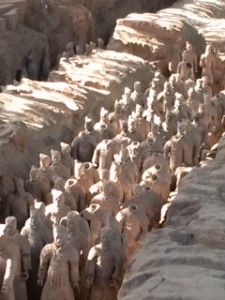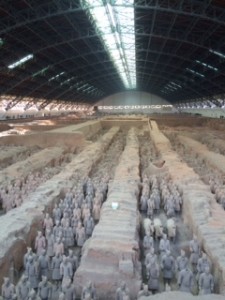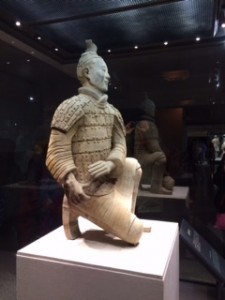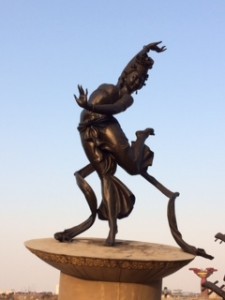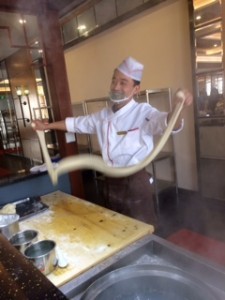Day 3 13th December 2014
Up before crack of dawn, packed breakfast (yuck) and on bus to airport. Xi’An coming, and we’ve never been before. Our organisation has given us plenty of time to check in which is just as well. You cannot take opened bottles of alcohol in checked luggage. We had some opened whisky of the expensive and hard to come by variety and had a choice between throwing it away or drinking it. Tough decision.
Anyway. We made it through the rest of the lovely lovely airport feeling in love with the world and looking forward to our next big adventure. Three hours later we came down to earth at Xi’An airport. Very very cold.
Met by Jerry (“as in Tom and Jerry” he assured us) who turned out to be a very amiable and knowledgable chap who understands the requirement for regular refreshment (and consequent restroom breaks), whilst ensuring that we stay on schedule and see everything that we are supposed to see. In my mind, Xi’An is a tourist destination, but it is also a city of 9 million people and has 40 universities, and plenty of heavy industry manufacturing specialist car parts and buses.
Back to the tourist bit – outside the city lives the Terracotta Army, and this was what we had come to see. By now being hardcore tourists we went straight there from the airport, with a history lesson from Jerry on the way. The emperor Qin Shi Huang who unified China and ended the Warring States period came to the throne at the age of 13 and immediately ordered that his tomb be built.
He died at the age of 50, so there was plenty of time to get it ready and the Terracotta Warriors were also produced to keep him company in the afterlife. His tomb remains sealed and unopened at the same site, waiting for archaeology technology to be able to preserve what is inside when it is opened. One of the reasons the tomb has remained untouched by grave robbers (or should we call them tomb raiders?) is that the people who designed and built the tomb sealed themselves up inside when the emperor was interred so that no-one would know the secret of how to open it. That’s dedication to the job.
Many such tombs are sealed up in China, with an embargo on opening them and exposing the contents to the effects of light and oxygen, especially after the disastrous opening of the Ming Tombs near Beijing. Anyway, back to his companions in death.
You can see as many documentaries as you like, Google it, look at postcards, buy books on it, but nothing is like seeing the standing army before you in rows and rows. Even after 40 years of work, there are still thousands left to be excavated and repaired.
The Warriors are buried in long corridors and originally had a roof above them, but it was burned down 2 years after the Emperor died when the Qin Dynasty ended. Thus, the soil and earth above collapsed onto the Warriors and crushed them. It is painstaking work of master jigsaw puzzlers to put them back together.
I am not sure why but I found the presence of the horses to be most moving. Regal beasts with fire and spirit showing in their eyes and flared nostrils, their fore locks ruffled in front and their clipped manes standing along strong necks. Standing four abreast as though patiently waiting for orders to move.
The soldiers have unexpectedly kindly and happy faces, chiselled and purposeful, each one an individual. The soldiers at the edges of the ranks are facing outwards as though on guard for the rest. The museum itself is understated and leaves the exhibits to speak for themselves. We can see some close up in glass cases where they are even more magical than seeing them in the massed ranks in the pits. The most complete figure is of a kneeling archer, who was not as crushed as the standing soldiers and horses. His empty hands are ready for action.
After an unexpectedly excellent lunch (including hand-pulled noodles and Chinese sloppy joes), we go to see pits 2 and 3. These contain the Terracotta Warriors of the Headquarters and the Supply Division – the army really is complete. Pit 3 has not yet been excavated as Pit 1 is still in progress. The archaeologists are also waiting for technology to become available which will allow them to preserve the painted colours on the terracotta which has oxidised on the other soldiers.
Day 3 part 2
So our sightseeing wonders were to continue by seeing some more wonders but of the Tang Dynasty. This was wealthiest of all the Chinese Dynasties. So whilst back in Blighty we were wandering about in the Dark Ages, Lady Yang was swanning around in silks taking hot spring baths in the shape of crab apple flowers. The Tang Dynasty Winter Palace was long since destroyed, so we had the dubious pleasure of wandering around a reconstruction.
The baths were original and the area is now becoming a hot springs resort area for retired members of the armed forces, and tourists in due course. In the summer time they put on a show dramatising the “Song of Everlasting Sorrow”. By the famous poet Bai Juyi, it tells the story of the most beautiful woman ever in China, Lady Yang Wei Fei. Although the concubine of the Emperor’s son, she became at 20 years old a 7th level concubine of the 50 year old Emperor.
Within 2 years she worked her way up to 1st level concubine (apparently that’s pretty quick). Coming from a wealthy mercantile family she was well-educated and well-travelled and often advised the Emperor on matters of state. He spent more time with her than any other wife or concubine. Like Anne Boleyn with Henry the Eighth, her brothers and family also became powerful and received lands and titles from the Emperor.
This led to jealousy and resentment. When the Emperor needed to send the army to deal with some troubles the Generals refused to go on the basis that the Army budget had been cut because of his infatuation. It all came to a sad end which resulted in one of the greatest poems of the Chinese language (plus a summertime song and dance show at the Winter Palace).
Anyway, back to real life. Dinner better than in Beijing. The noodles around here are first class – the famous lantian noodles which you may have had at camp with beef and chilli. Vegetables pretty good but not on a par with the freshness and variety of Yongchun.
Finally made it to hotel which was very good 4 star establishment. Boiling hot rooms and comfortable beds. The youngsters headed off into the Muslim quarter for street food and beer, and the old emperors went straight to bed.
